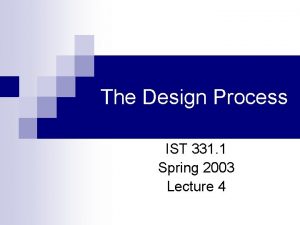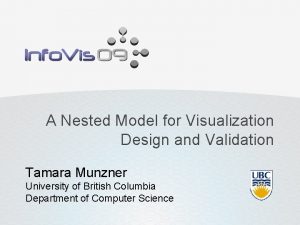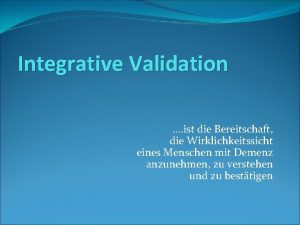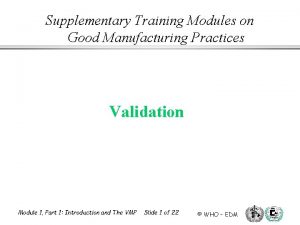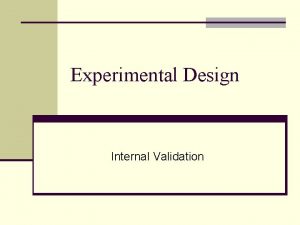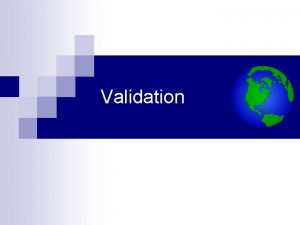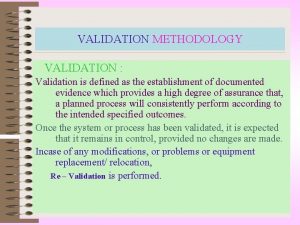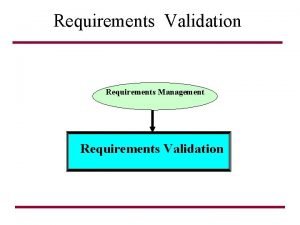Experimental Design Internal Validation Experimental Design I Definition











- Slides: 11

Experimental Design Internal Validation

Experimental Design I. Definition of Experimental Design II. Simple Experimental Design III. Complex Experimental Design IV. Quasi-Experimental Design V. Threats to Validity

Experimental Design I. Definition of Experimental Design Control over the sequence and proportion of the independent variable involving: 1) at least two conditions (i. e. an independent variable); 2) random assignment of subjects to conditions; and 3) the measurement of some outcome (i. e. dependent variable)

Experimental Design II. Simple Experimental Design 1. Post-test Control Group Designs (t-test) E R X -> O 1 C R Example -> O 2 2. Pre-Post-test Control Group Designs (t-test) E R O 1 X -> O 3 C R O 2 -> O 4

Experimental Design II. Simple Experimental Design 3. Soloman Four Group Design (t-test) E 1 R X 1 -> O 1 C 1 R -> O 2 E 2 R O 1 X 1 -> O 3 C 2 R O 2 -> O 4 4. Analysis of Variance (ANOVA) E 1 R X 1 -> O 1 E 2 R X 2 -> O 2 E 3 R X 3 -> O 3 Example

Experimental Design III. Complex Experimental Design (Factorial Designs) uses ‘Two Way Analysis of Variance’ 1. Completely Randomized Designs (CRD) (This example is a 2 x 3 CRD) C-E 1 C-E 2 C-E 3 R-E 1 O 12 O 13 R-E 2 O 21 O 22 O 23 Main Effects Interaction Effects

Experimental Design III. Complex Experimental Design (cont. ) 2. Incomplete Designs (IRD) Split Plot Design (This example is a 2 x 3 SPD) C-E 1 C-E 2 C-E 3 R-E 1 R-E 2 3. - O 12 O 21 O 22 O 13 - Repeated Measures Designs (RMD) Latin Square Design ( This example is a 4 x 4 4. LSD) O 1 O 2 O 3 O 4 O 1 O 2 O 3

Experimental Design IV. Quasi-Experimental Design 1. One Shot Case Study E O 1 X ->O 2 2. Non-Equivalent Control Group Design E O 1 X -> O 3 C O 2 -> O 4 3. Interrupted Time-Series Design E O 1 O 2 O 3 X O 4 O 5 O 6

Experimental Design V. Threats to Validity 1. History = confounding of IV over time 2. Maturation = age / experience contaminate 3. Testing = subjects come to understanding IV 4. Regression to the Mean = extreme scores regress 5. Selection of Participants = non-random assignment 6. Mortality = subject attrition 7. Diffusion of Treatments = lack of control group Back to the Beginning End Presentation

Two Sample t-test Problem: Suppose you wanted to know if students who work (the experimental condition) take fewer units than students who do not (the control condition). If a sample of 25 working students yielded a mean of 12 units with an unbiased standard deviation of 3 units and 25 who do not work took an average 15 units with an unbiased standard deviation of 4 units, could you conclude that the population of students not working take significantly more units? Step 1 State the hypotheses: Ho: = ; H 1: < Step 2: Specify the distribution: (t-distribution) Step 3: Set alpha (say. 05; one tail test, N>30, therefore t= 1. 65) Step 4: Calculate the outcome: Step 5: Draw the conclusion: Reject Ho: 3. 0 > 1. 65 Working students take significantly fewer units. Back

Multiple Sample Test (ANOVA) Problem: Suppose your instructor divides your class into three sub-groups, each receiving a different teaching strategy (experimental condition). If the following test scores were generated, could you assume that teaching strategy affects test results? 2= 3; H 1: Ho is false At Home 115 125 135 145 155 Step 3: Set alpha (say. 05; therefore F = 3. 89) 140 150 160 Step 4: Calculate the outcome: 145 155 165 175 185 140 150 Both C+H Step 1: State hypotheses: Ho: 1 = In Class 160 Grand Mean = 150 Step 2: Specify the distribution: (F-distribution) Source SS df MS F Bet 1000 2 500 1. 54 Within 3900 12 325 Step 5: Draw the conclusion: Retain Ho: 1. 54 < 3. 89 Type of instruction does not influence test scores. Back
 Experimental vs non experimental
Experimental vs non experimental Experimental vs non experimental
Experimental vs non experimental Experimental research design types
Experimental research design types Experimental vs non experimental research
Experimental vs non experimental research Experimental vs non experimental
Experimental vs non experimental Ist 331
Ist 331 A nested model for visualization design and validation
A nested model for visualization design and validation Non-experimental design definition
Non-experimental design definition Dq design qualification
Dq design qualification Retrospective validation
Retrospective validation Integrative validation
Integrative validation Validation definition
Validation definition





